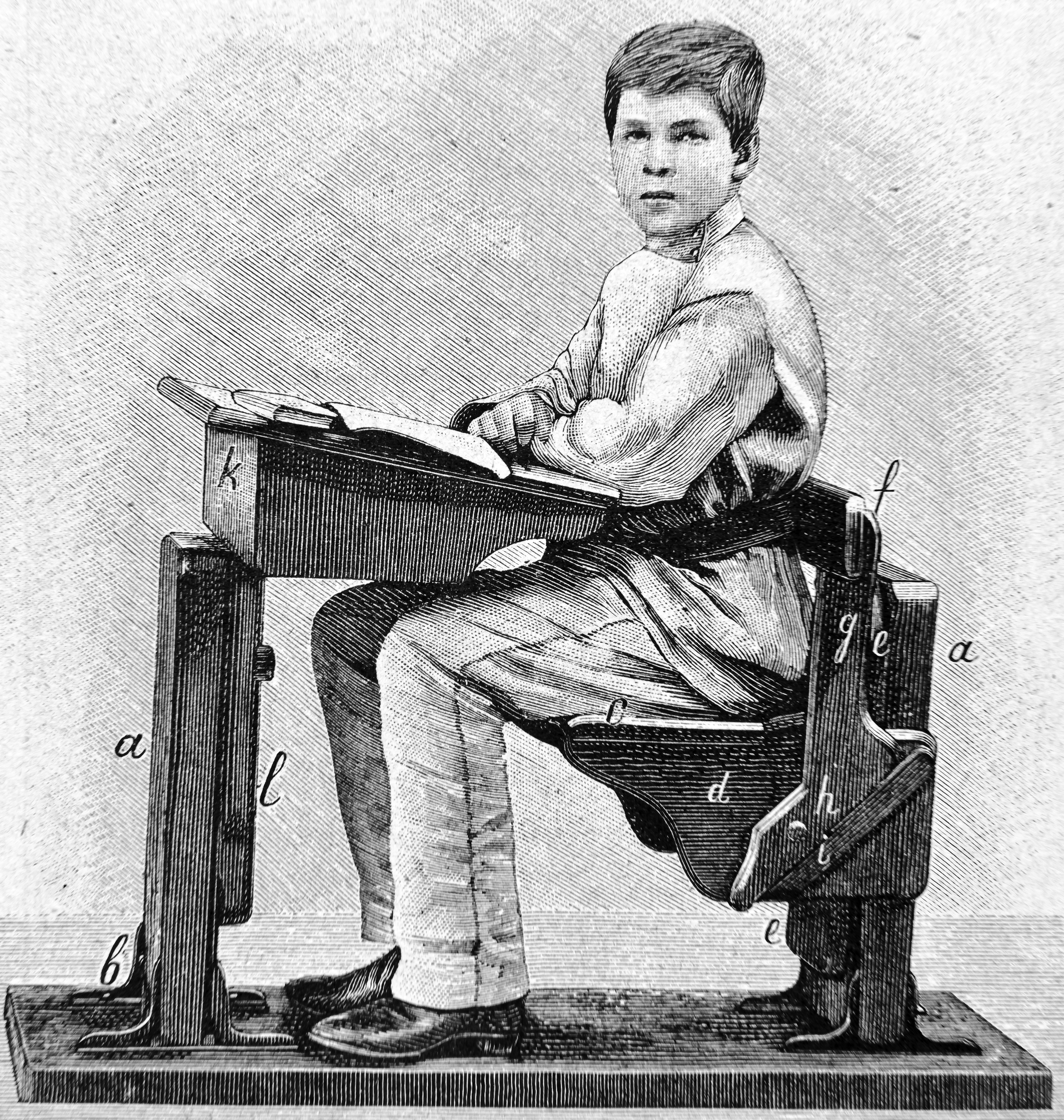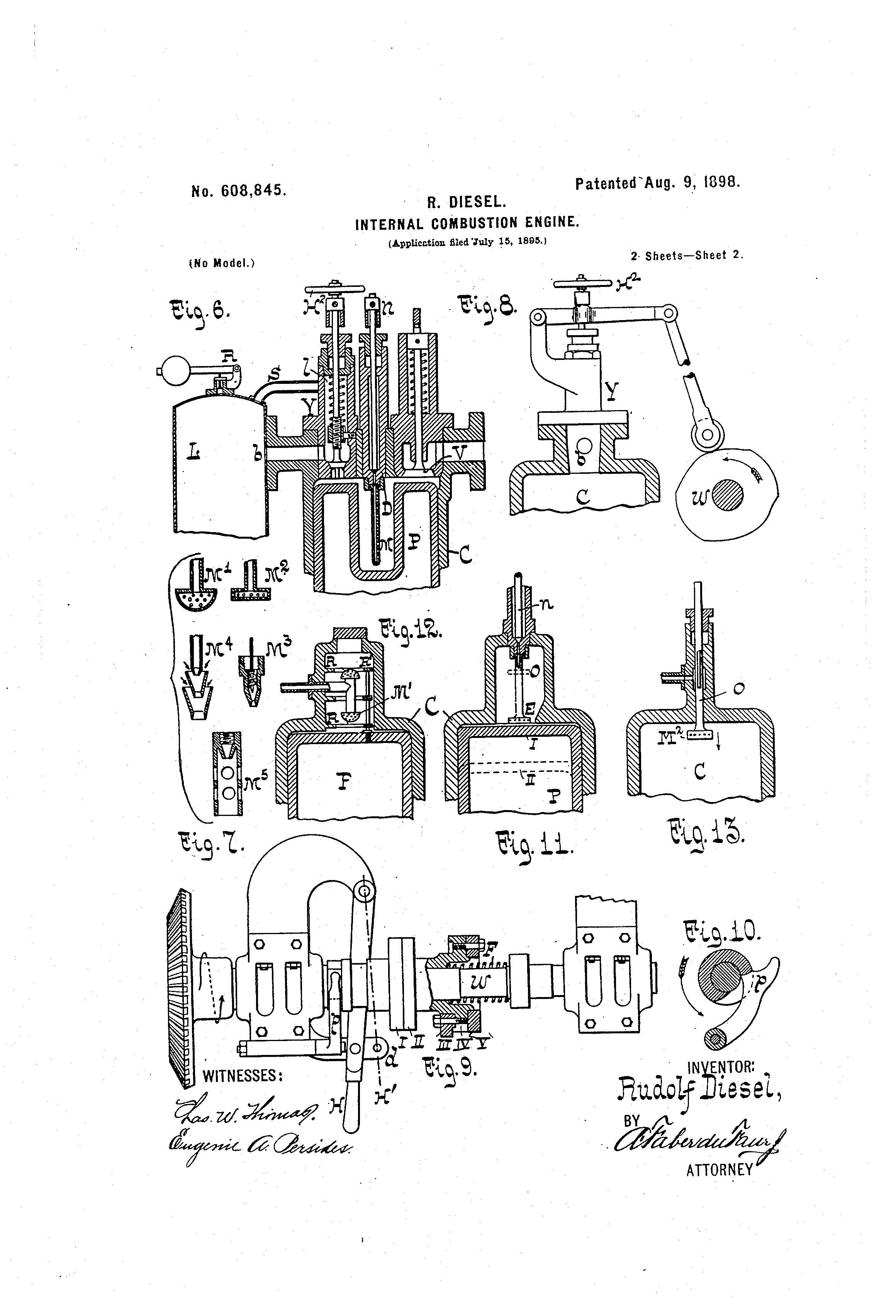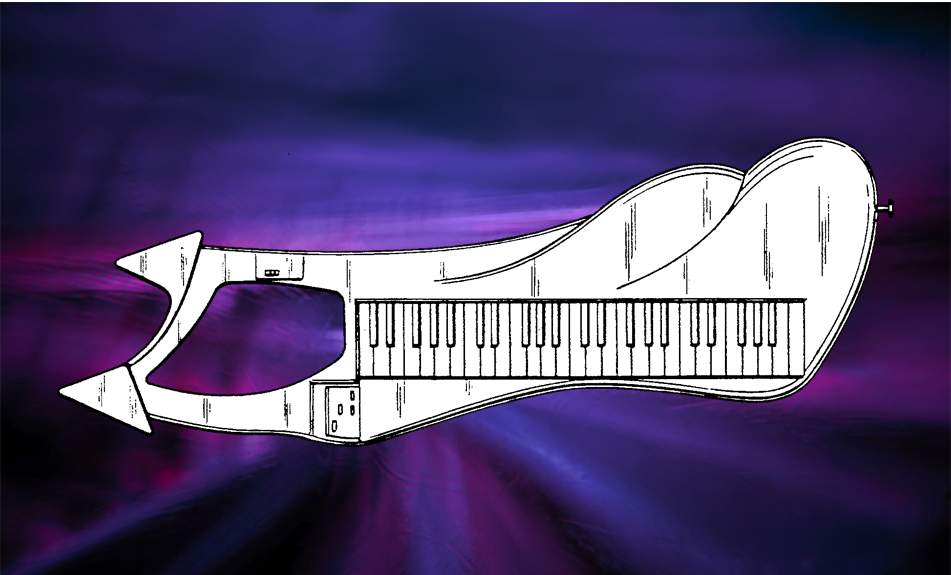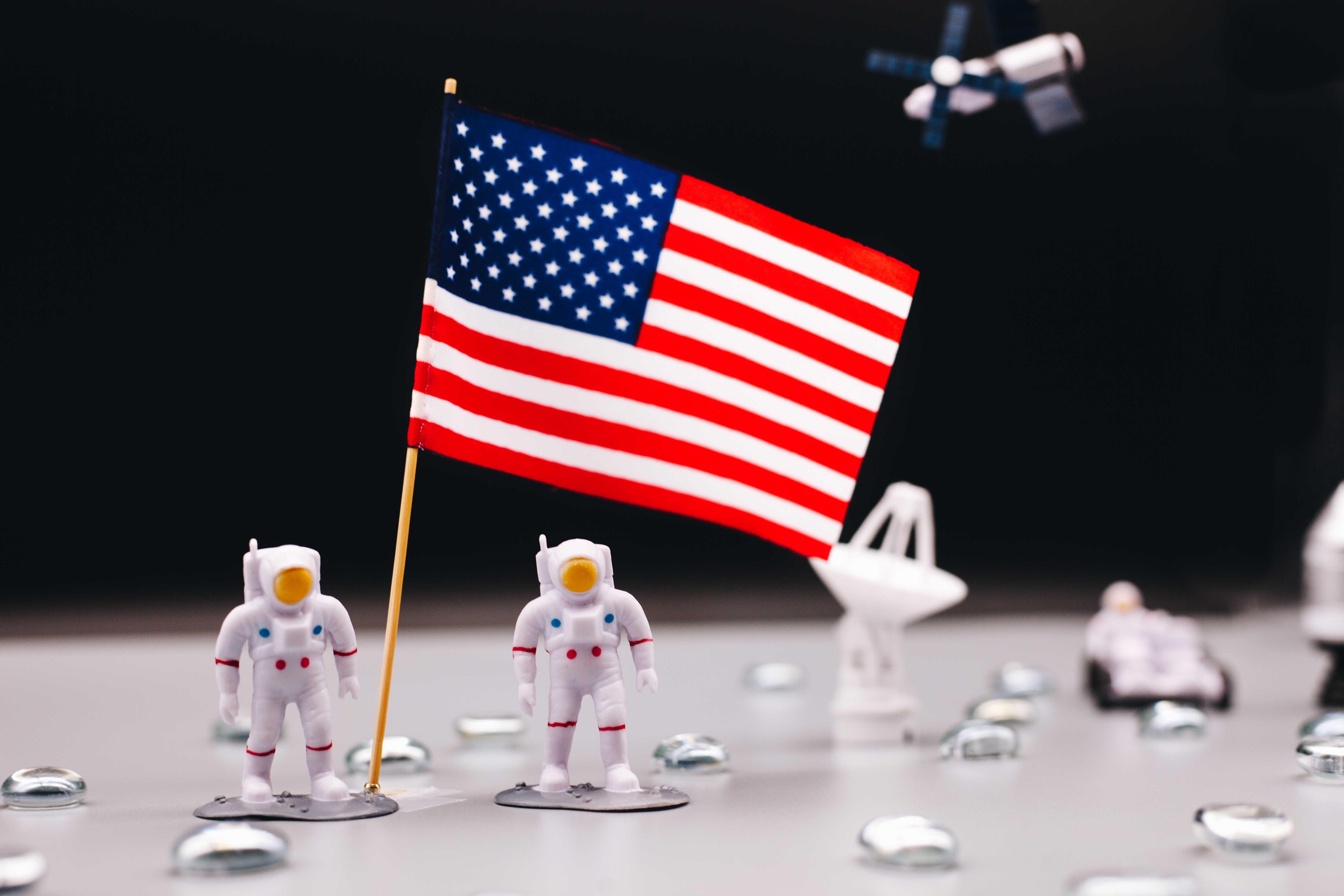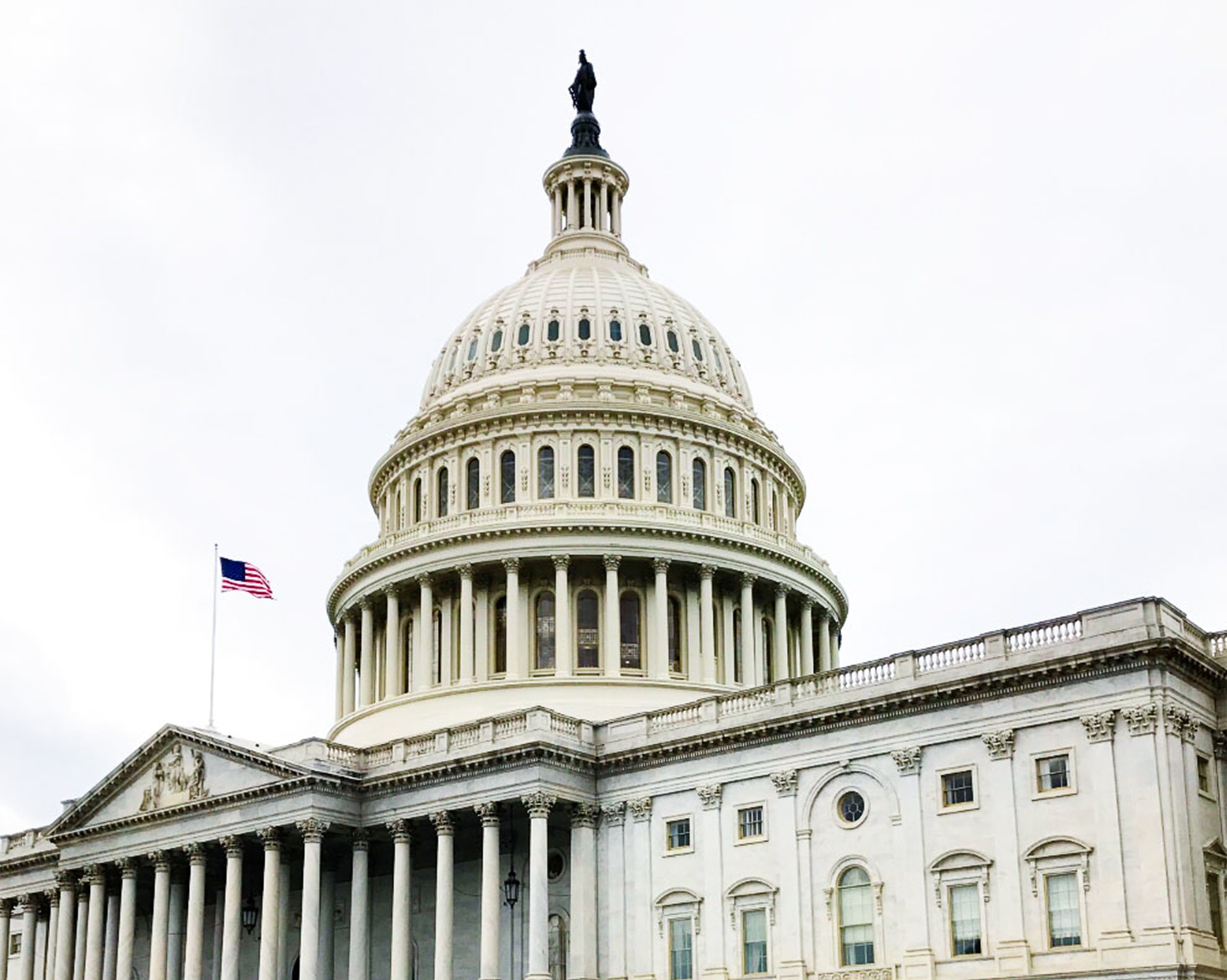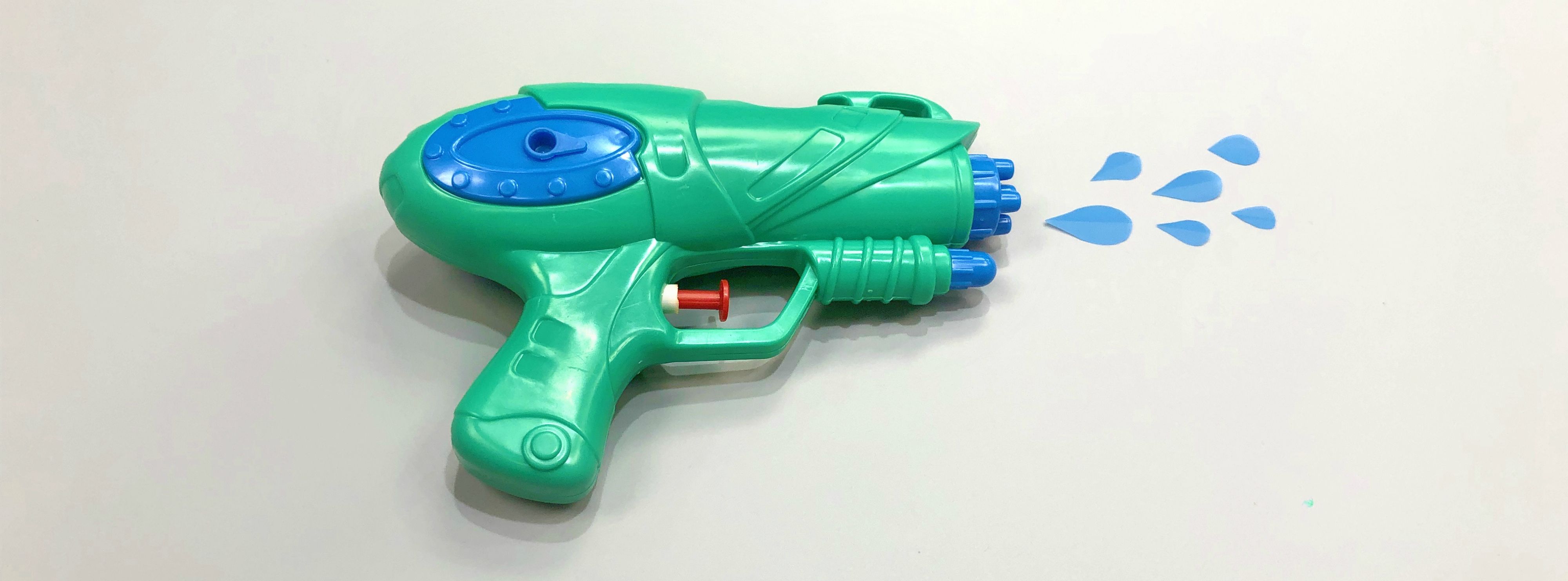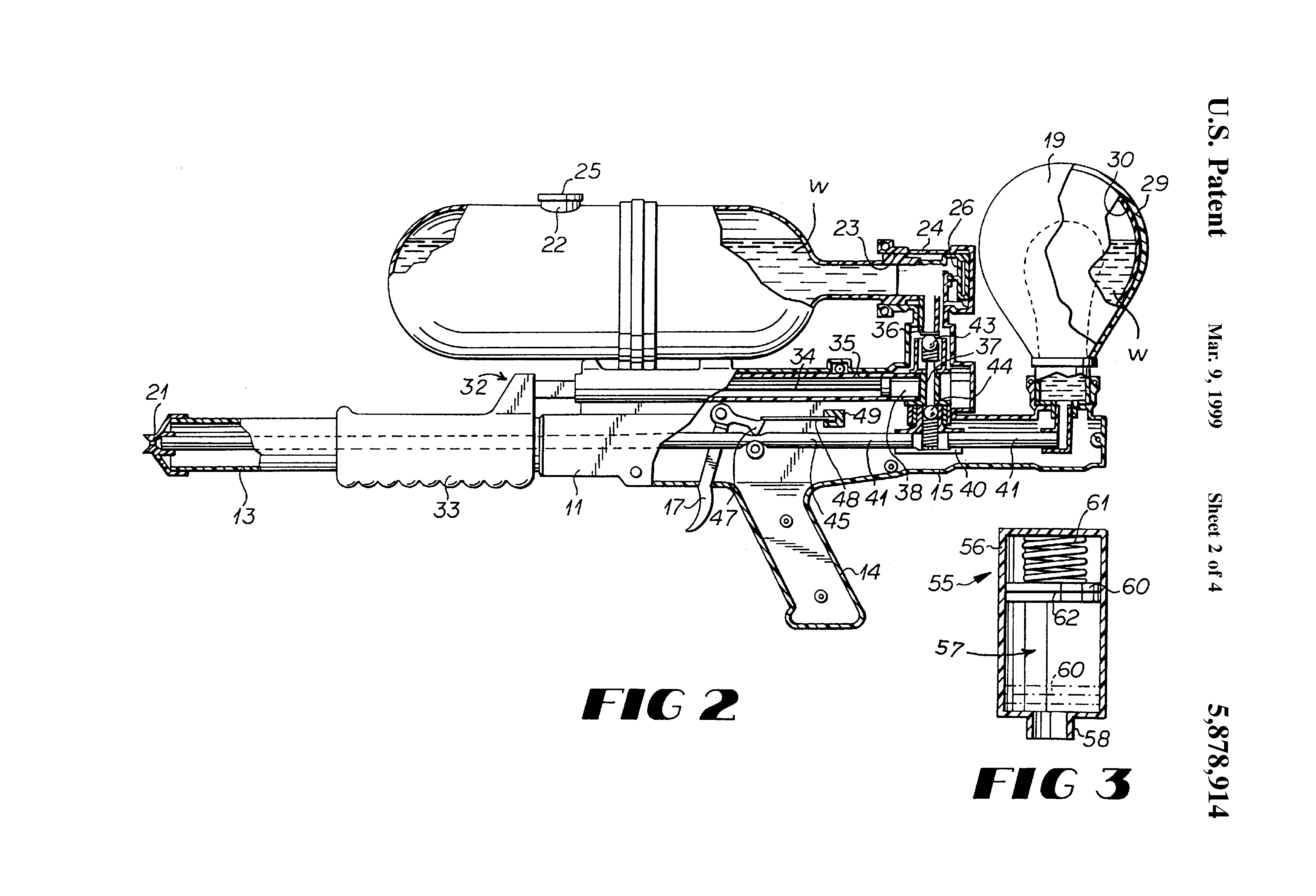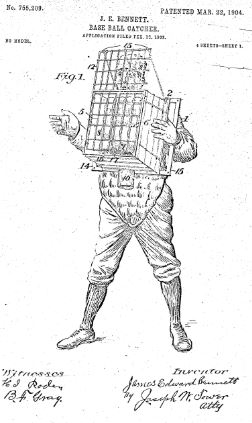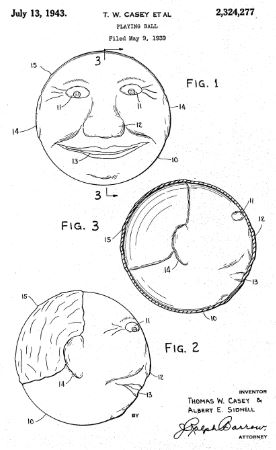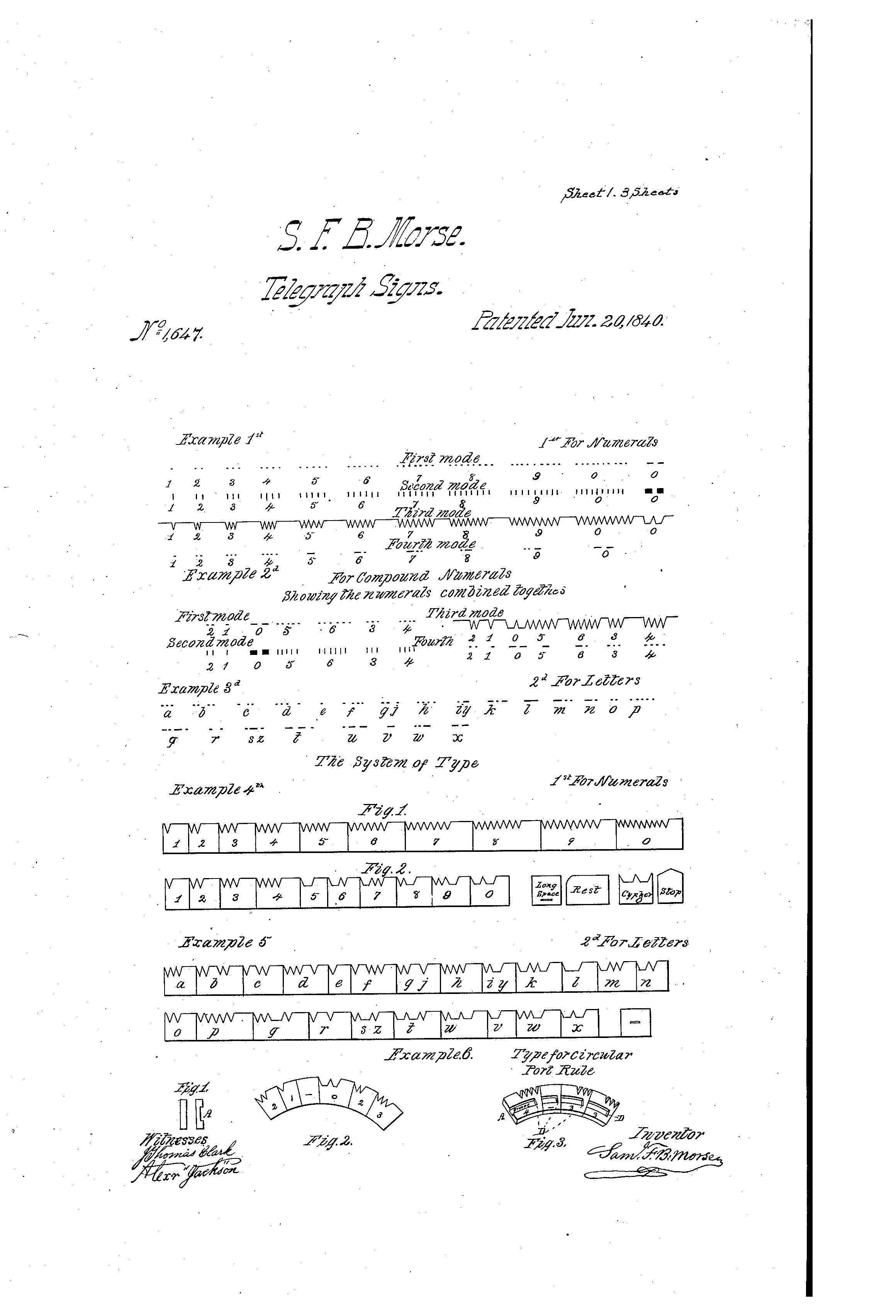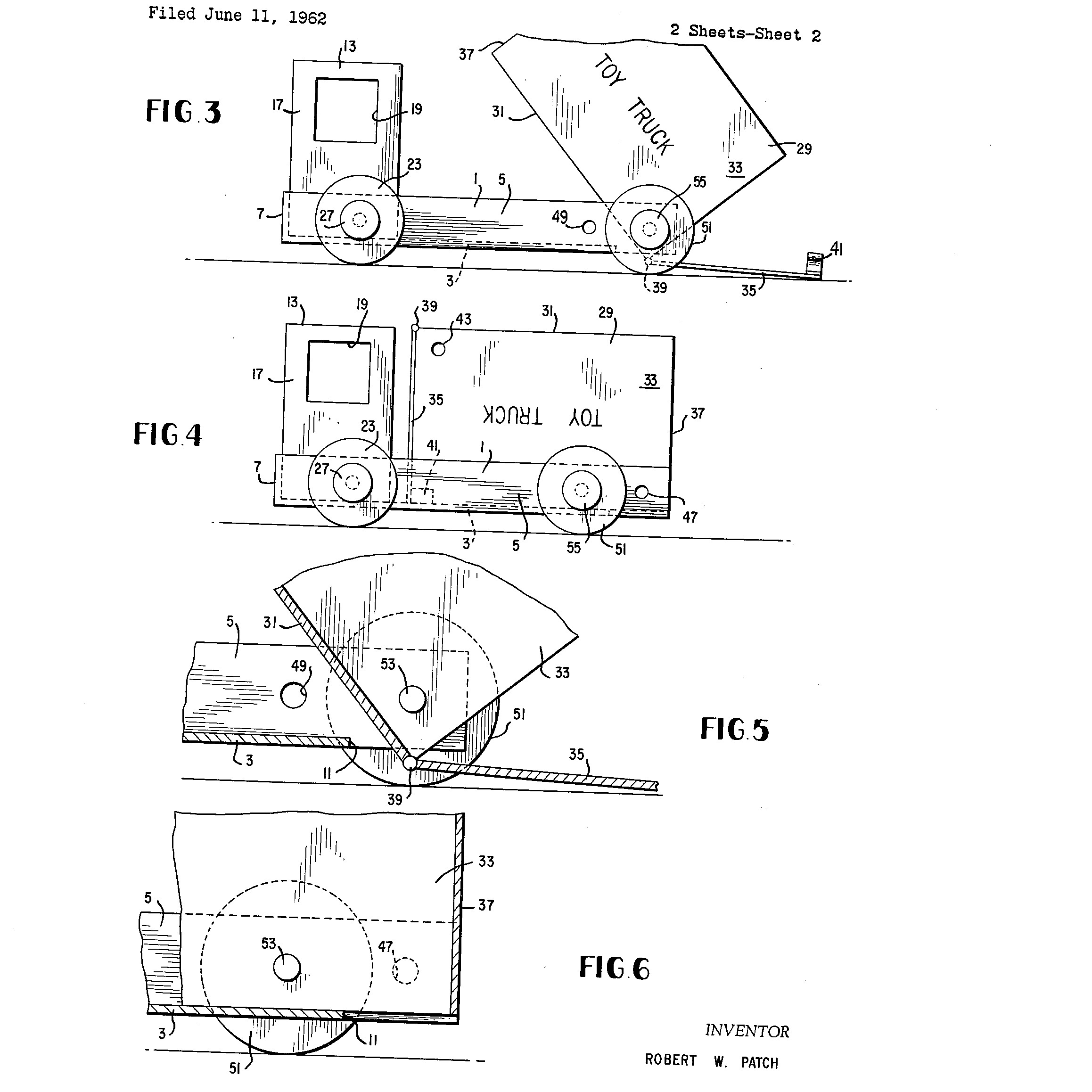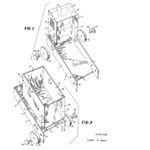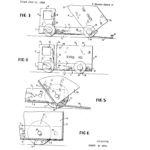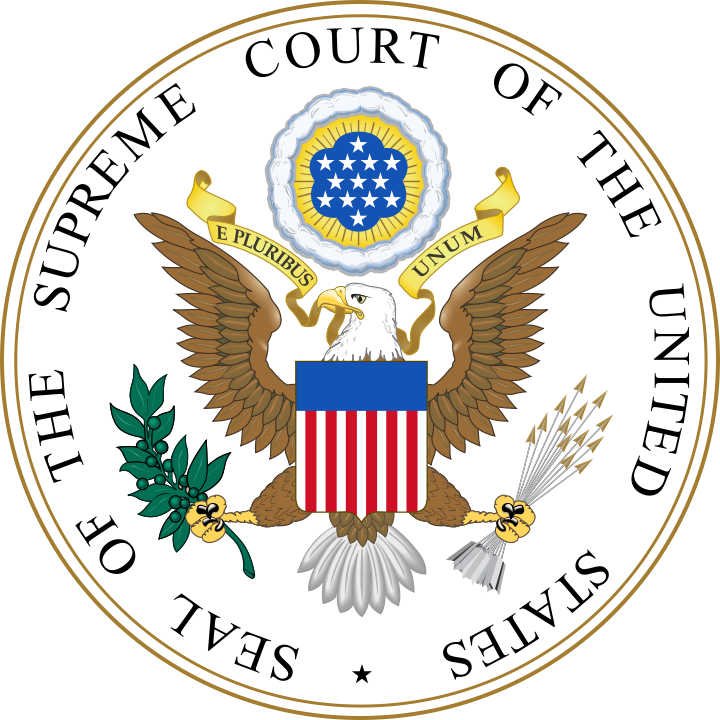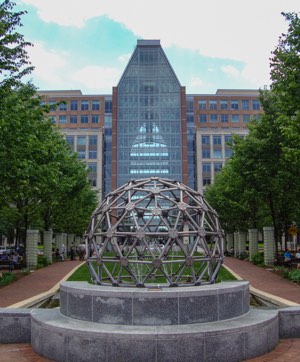Have a Seat– A Brief History of School Desk Patents
New wardrobe has been purchased, school supplies have been stocked, lunch is packed, now it's time for your first patent history lesson of the new school year-- a brief history of school desk patents!
The "Fashion Desk"
Although desks like Herbert L. Andrews’ “SCHOOL DESK” (U.S. Patent No. 82,061) had been patented earlier, John Loughlin, Founder of the Sidney School Furniture Company, is credited as the inventor of one of the first, most popular desks of the 1880s, the “Fashion Desk.”
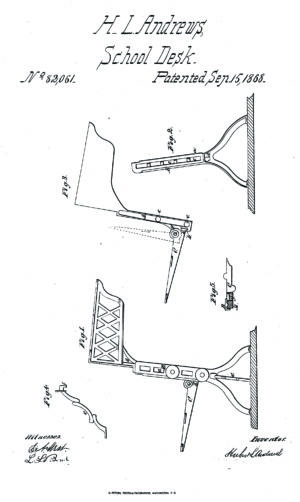
One innovative feature of Loughlin’s desk was its "T-Head" structure. This assembly allowed many desks to be assembled together, rather than bolted to the floor. Most fashion desks also included a built-in inkwell, allowing students to re-ink their pens without leaving their desk.
Although Loughlin never received a patent for the fashion desk, Anna Breadin received a patent for the desk she modeled after Loughlin’s desk, “SCHOOL DESK,” (U.S. Patent No. 400,738) in 1889. The Sidney School Furniture Company sold and manufactured the model, and it remained popular for many years.
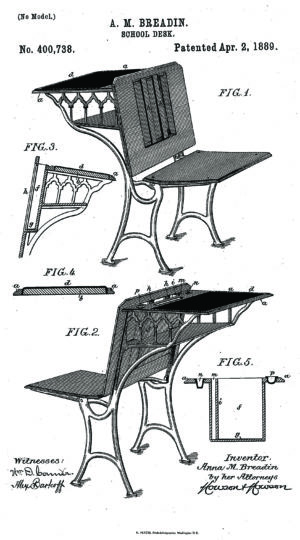
The Welsh Desk
As time went on, wider desks like the Welsh School Desk were made to accommodate the growing number of students in the classroom during the 1920s. These desks could seat two students side-by-side and had double compartment storage allowing students to access their school supplies easily.
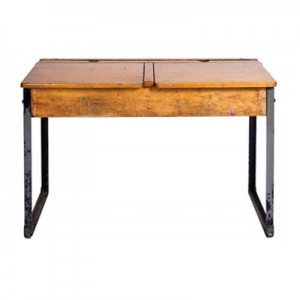
The "Adjustable School Desk"
In the 1930s, a desk known as the “Adjustable School Desk” permitted students to make vertical adjustments of the desk and the seat. It also allowed the student to swivel their chair from side-to-side. A patent of this desk was granted to George H. Abbott on April 30, 1930, entitled “COMBINED DESK AND SEAT” (U.S. Patent No. 1,883,322).
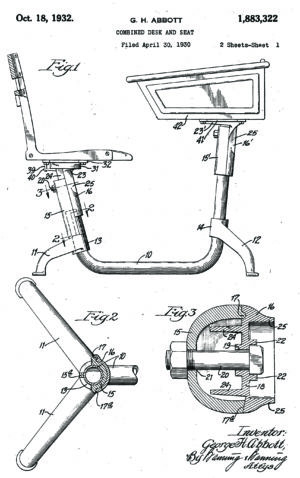
The One-Armed Desk
Desks continued to evolve into 1970s. One of the more popular models was the fiberboard, plastic, and chrome wrapped desk, “TABLET ARM FOR WIRE ROD CHAIR,” (U.S. Patent No. 4,159,841). This desk swapped the storage area from the top of the desk to space under the seat for a backpack, leaving a more limited space for students to write, and a headache for left-handed students. Although there was a brief break in this style of desk during the 1980s to a hollowed steel and plywood-topped desk, many schools returned to the 1970s model because of their more affordable price.

Desks for Health and Saftey
As the new millennium approached, newer desks focused on the health and safety of students. For example, “STUDENT EXERCISE DESK” (U.S. Patent No. D637,663), was designed as a stand-alone desk, high enough to allow a student to stand without using a stool or chair. Workplaces encouraged this trend as well, allowing office workers the option to sit or stand during their workweek.
In the wake of increasing tragic events, schools have also tried to put a heavier emphasis on the safety of students. Patents like “DESK AND REMOVABLE BULLET RESISTANT DESKTOP SHIELD” (U.S. Patent No. 6,170,379) aimed to add more safety and security to schools by doubling as protection.

Although desks have changed throughout the years, many traits of the original designs can be found in those created today. Which desks did you sit in when you went to school? Be sure to let us know on our social channels. We're active on Facebook, Twitter, and Instagram!
Suiter Swantz IP is a full-service intellectual property law firm providing client-centric patent, trademark, and copyright services. If you need assistance with an intellectual property matter and would like to speak with one of our attorneys, please contact us at info@suiter.com.
Rudolf Diesel's "Internal Combustion Engine"
On August 9, 1898, Rudolf Diesel was granted U.S. Patent No. 608,845A, for his "INTERNAL COMBUSTION ENGINE."
Rudolf Diesel, who is best known for the invention that bears his name, was born in Paris, France in 1858.
In 1885, Diesel wanted to build a better, more efficient engine that could help independent artisans, entrepreneurs, and smaller businesses compete with larger industries who predominately used expensive steam engines for power at the time. Eight years later, Diesel's model ran on its own power for the first time. Throughout the 1890s, Diesel received several patents for his invention of the efficient, pressure-ignited heat engine, and by 1898, he was granted U.S. patent #608,845A for his internal combustion engine.
Although one of Diesel’s main goals was to make energy more efficient and affordable for smaller businesses to compete with bigger companies, industrialists also embraced his invention quickly, which helped spur the Industrial Revolution's rapid development. Following his death, diesel internal combustion engines became common in automobiles, trucks, ships, trains, and more. The diesel engines of today are refined and improved versions of Rudolf Diesel's original concept.
Suiter Swantz IP is a full-service intellectual property law firm providing client-centric patent, trademark, and copyright services. If you need assistance with an intellectual property matter and would like to speak with one of our attorneys, please contact us at info@suiter.com.
The Patent Behind Prince's Keytar
On July 26, 1994, Prince R. Nelson was granted a design patent for his infamous keytar: PORTABLE, ELECTRONIC KEYBOARD MUSICAL INSTRUMENT, U.S. Patent No. D349,127
Prince Rogers Nelson was born on June 7, 1958, in Minneapolis, Minnesota. During the 1980s, Prince emerged as one of the most talented up and coming musicians. He wrote his first song at the age of seven and taught himself how to play piano, drums, guitar, and eventually his keytar. His career began with the jazz band, the Prince Rogers band. In 1978, Prince signed with Warner Bros. Records and in 1992 signed the largest recording and music publishing contract in history (at the time) for $100 million. He won eight Grammy Awards, six American Music Awards, a Golden Globe, and an Academy Award. He was also inducted into the Rock and Roll Hall of Fame in 2004. A few of his most popular hits include, “When Doves Cry,” “Purple Rain,” “Kiss,” and many more.
Prince was a heavy defender of his intellectual property. In 2015, he made it clear that he did not want his music to appear online by pulling his songs from Spotify and Youtube due to unfair compensation. At one-point Price even had a $22 million lawsuit against 22 people who posted his live shows on social media. The lawsuit was eventually dropped but showed how serious he was about protecting his music. “Technology is cool but you’ve got to use it as opposed to letting it use you,” Prince said.  On top of being an award-winning singer, songwriter, and musician he was also an inventor. Prince designed a portable electronic keyboard on a guitar’s frame he dubbed the "Purpleaxxe." The instrument looks partly inspired by the glyph that served as Prince's name for a good portion of the '90s. The custom guitar-keyboard hybrid, or a "keytar," was invented for his keyboardist, Tommy Barbarella.
On top of being an award-winning singer, songwriter, and musician he was also an inventor. Prince designed a portable electronic keyboard on a guitar’s frame he dubbed the "Purpleaxxe." The instrument looks partly inspired by the glyph that served as Prince's name for a good portion of the '90s. The custom guitar-keyboard hybrid, or a "keytar," was invented for his keyboardist, Tommy Barbarella.
After filing with U.S. Patent and Trademark Office, Prince was granted U.S. Patent No. D349,127 in 1994. It's unclear how often the Purpleaxxe made appearances at Prince's shows, but a Google image search shows it wasn't just a flight of fancy— the keytar made appearances on stage more than once and probably inspired others to create their own versions as well.
Prince died on April 21, 2016. The next year his estate brokered new deals that allowed streaming services everywhere to publish his music. Even though it may not have been something he wanted, it was a gift to fans all over the world who mourned the loss of the artist previously known as Prince.
Suiter Swantz IP is a full-service intellectual property law firm providing client-centric patent, trademark, and copyright services. If you need assistance with an intellectual property matter and would like to speak with one of our attorneys, please contact us at info@suiter.com .
Celebrating the 50th Anniversary of the Apollo 11 Lunar Mission
July 20, 2019, marks the 50th anniversary of NASA's Apollo 11 lunar mission.
Apollo 11 astronauts Neil Armstrong and Buzz Aldrin became the first humans to walk on the moon on July 20, 1969. The lunar landing marked the culmination of America's Cold War human spaceflight program and positioned the United States as a global leader in science and technology.
In 1961, when President John F. Kennedy announced the goal of "landing a man on the moon and returning him safely to the earth" before the end of the decade, the mission seemed all but impossible.
Fifty years later, the world is remembering the historic mission and its impact on society and science. To celebrate the anniversary, we’d like to highlight a patent that was an integral part of the mission, the Apollo space suit.
The Apollo Space Suit
In 1968, the National Aeronautics and Space Administration (NASA) filed a patent application for the space suit designed for the astronauts in the Apollo Space Program (U.S. Patent No. 3,751,727A). NASA’s patent was later granted on August 14, 1973. The space suit was designed to be worn both inside and outside of the space vehicle as well as on the lunar surface.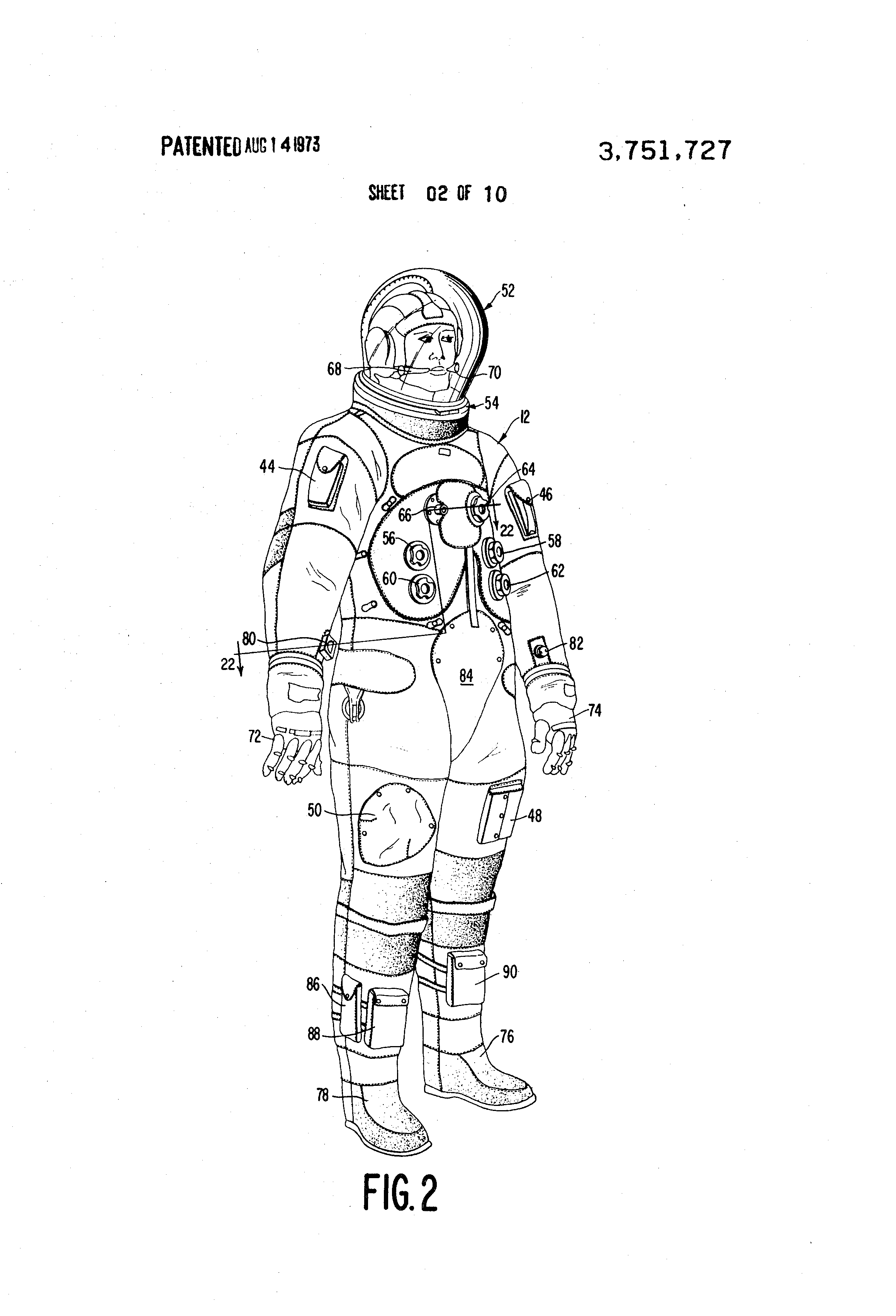
Each suit was hand-built by seamstresses who had to be extraordinarily precise as one small error could be the difference between a functional space suit and a potential safety hazard. The space suits were built with a state-of-the-art fabric called Beta cloth, to withstand temperatures of over 1,000 degrees Fahrenheit.
What many don’t know, is that the space suit was created by the International Latex Corporation (ILC) in Dover, Delaware, later known as Playtex.
Yes, the company that brought America the “Cross Your Heart Bra” in the mid-1950s were responsible for bringing NASA’s historical suit to life. ILC had sold the skill of its industrial division to NASA as the company had a lot of expertise developing clothing that had to be flexible as well as form-fitting.
The toughest challenge for ILC was to contain the pressure necessary to support life (about 3.75 pounds per square inch of pure oxygen), while maintaining enough flexibility to afford freedom of motion.
The Apollo suits were used on 11 missions from 1968 until 1972, resulting in 158 combined hours on the lunar surface. There was never a mission that had to be cut short or canceled due to a problem with the Apollo space suits. The Apollo 11 space suits would go on to be the basis of the iconic image of a man on the moon in photos of Buzz Aldrin and the eleven others who traversed the lunar surface.
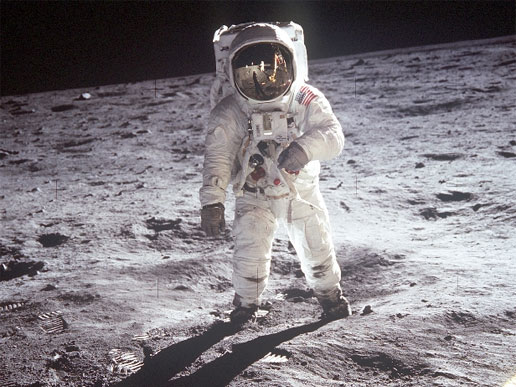
ILC is just one example of the many inventors and everyday companies that helped America land on the moon. 50 years later, the success of the mission still plays a powerful role when discussing the future of American innovation. The accomplishment poses the exciting question, “If we were able to put a man on the moon, what else can we do?”
Suiter Swantz IP is a full-service intellectual property law firm providing client-centric patent, trademark, and copyright services. If you need assistance with an intellectual property matter and would like to speak with one of our attorneys, please contact us at info@suiter.com.
Coons and Stivers Reintroduce STRONGER Patents Act of 2019
Yesterday, July 10, Senator Chris Coons (D-DE) and Congressman Steve Stivers (R-OH) reintroduced the STRONGER Patents Act of 2019.
Coons and Stivers were joined by Congressman Bill Foster (D-IL), Senator Mazie Hirono (D-HI), and representatives from the National Small Business Association, Dolby Laboratories, the Association of American Universities, Biotechnology Innovation Organization and the Inventor’s Project.
Like the STRONGER Patents Act of 2015 and 2017, the latest iteration seeks to strengthen patent protections and promote American innovation.
During his opening remarks yesterday, Coons said, “Something is fundamentally wrong with a system that encourages patent infringers to avoid or delay negotiating with rights holders in good faith, and instead promotes costly litigation.”
He went on to explain that the STRONGER Patents Act of 2019 would restore a patent holder’s ability to receive an injunction after a patent has been proven both valid and infringed.
“Their focus should be on innovation, not defending themselves from abusive serial challenges to their patents at the PTAB,” said Coons. “The American Invents Act was designed to provide an efficient and affordable opportunity for the USPTO to have a second look at patent claims, not a 3rd, 4th, 5th, 6th look at patent claims. Our bill would prevent these and other abusive and repetitive attacks.”
If enacted, this provision would return more exclusivity to the patent holder while acknowledging the irreparable damage caused by patent infringers who take advantage of the PTAB system through serial review.
The event on Capitol Hill was recorded and posted to U.S. Senator Coons’ Youtube Channel which can be viewed below:
--
Suiter Swantz IP is a full-service intellectual property law firm providing client-centric patent, trademark, and copyright services. If you need assistance with an intellectual property matter and would like to speak with one of our attorneys, please contact us at info@suiter.com .
Independence Day Innovations
To celebrate America turning another year older, we are highlighting a few American innovations that make celebrating Independence Day so enjoyable.
The Fourth of July marks the anniversary of the signing of the Declaration of Independence and the birth of America. Initially, this meant celebrating freedom from tyranny and the opportunity to govern ourselves, but it has also come to be associated with everything from hot dogs, fireworks, and hot summer days to the actual American Dream itself—the ability to better ourselves, become whatever we want to be, and perhaps make the world a better place for those that come after us. In whatever way you choose to celebrate Independence Day, it’s certain that without innovation, America would not be what it is today.
The Modern Charcoal Briquette
Many folks celebrate the Fourth of July by grilling food with friends and family. Even if you don't consider yourself a "Grill Master," chances are you've tried a food that was made using charcoal.
In 1897, Ellsworth B. A. Zwoyer created and patented the first modern charcoal briquette (U.S. Patent No. D27,483). While there are many kinds of charcoal briquettes used today, Zwoyer was the first inventor to patent the charcoal briquette as an alternative to fuel.
Zwoyer's accomplishments were eventually overshadowed by those of Henry Ford who began making charcoal briquettes from scraps of wood leftover from his facilities. (Ford's early automobiles were made of wood from his lumber operations in Michigan's Upper Peninsula). The Kingsford Product Company began selling the briquettes in the 1920s and continues to be one of the most popular charcoal brands used today.
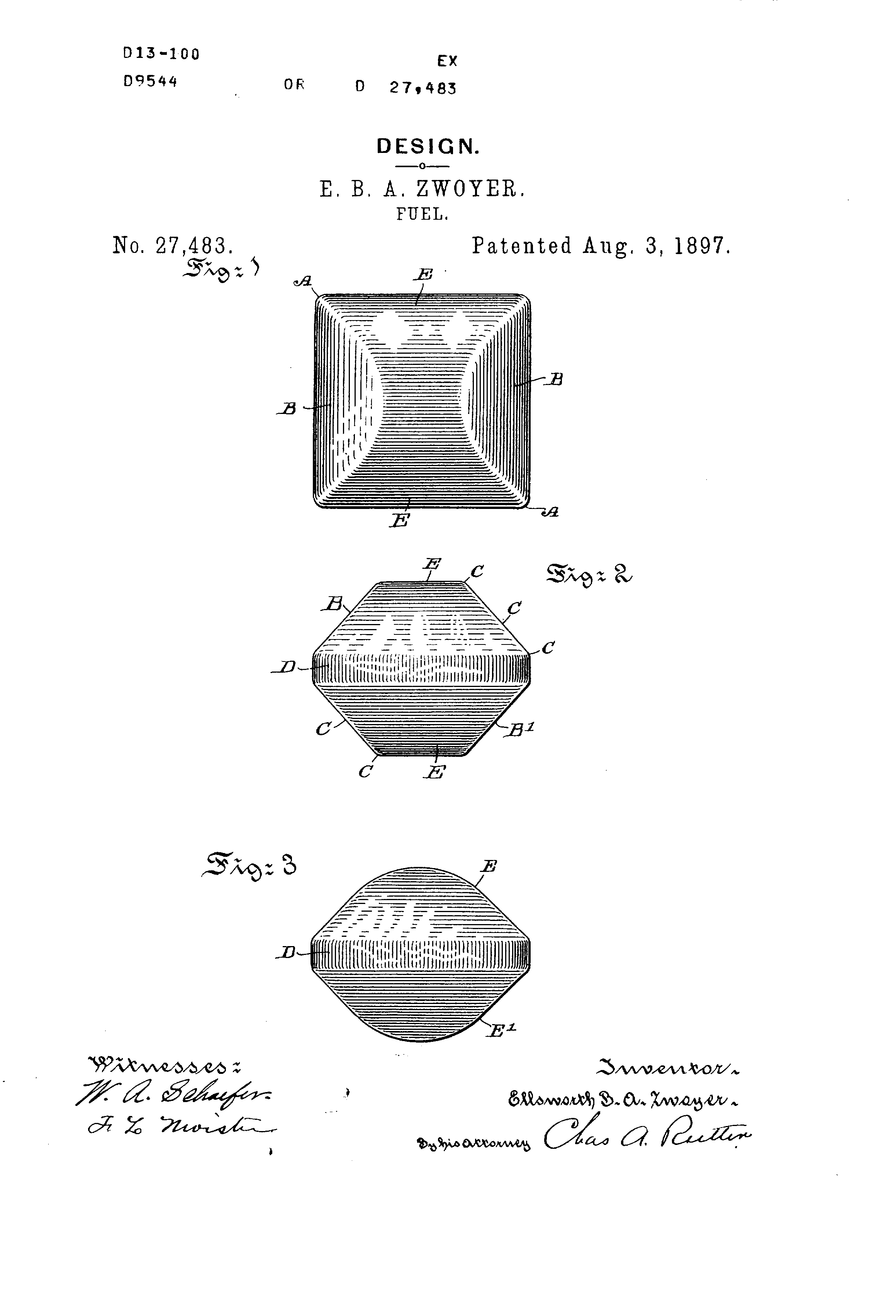
The Weber Grill
George Stephen Sr. is credited as the first inventor of the charcoal grill. Stephen, a welder at Weber Brothers Metal Works, primarily welded spears together to make marine buoys.
In 1952, Stephen split a buoy in half to make a dome-shape. He then welded legs on the lower half and fabricated the top half with a more shallow hemisphere. Holes were also added to allow the flow of oxygen needed to maintain a fire. Thus, the iconic Weber grill was born.
In 1959, the Weber Brothers Metal Works was acquired by Stephen Sr. and fifteen years later he was granted U.S. Patent No. 3,330,266, for the Barbecue Vessel. While Weber grills have significantly advanced from the disassembled marine buoy, they continue to sell and manufacture the classic charcoal grill.
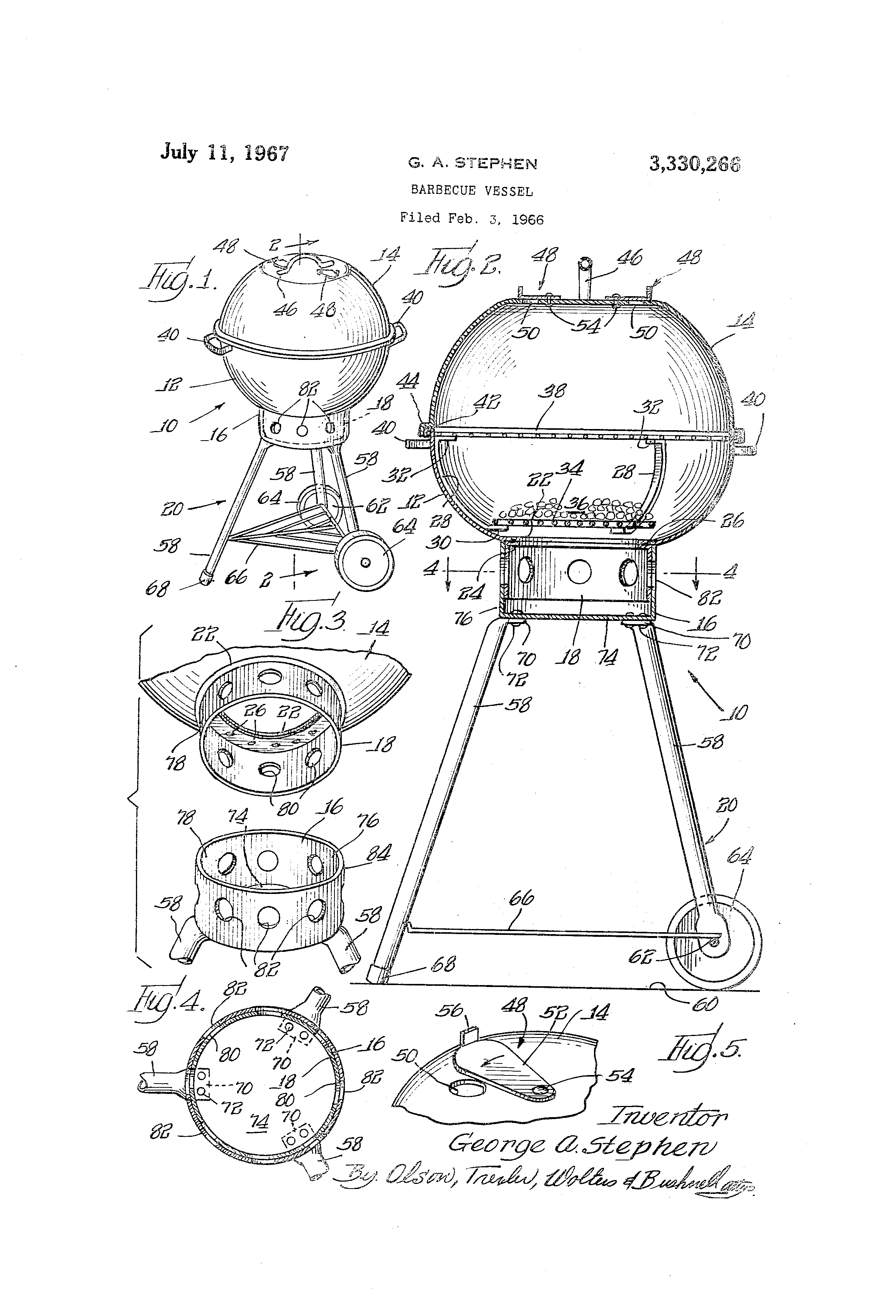
Sunscreen
There’s no denying that the Fourth of July can be a day of extreme summer heat. Whether you choose to spend this Fourth of July indoors or brave the summer heat, chances are you've used a variation of the following sunscreen patents and trademarks.
The earliest forms of sun protection were varieties of plant extracts. Ancient Egyptians used extracts of rice, jasmine and lupine plants, while early Greek civilizations used olive oil.
One of the first popular sunscreen products was invented for the United States military by Florida airman and pharmacist Benjamin Green in 1944. Green's patented "Red Vet Pet" was described as a sticky, red substance similar to petroleum jelly. Green created Red Pet Vet to help protect soldiers from the hazards of overexposure to the sun during the height of World War II in the Pacific tropics.
His patent was eventually acquired by Coppertone, which later improved and commercialized the substance and marketed it as brands like "Coppertone Girl" and "Bain de Soleil" in the early 1950s.
The Super Soaker
If you find yourself getting pelted with water by kids this Fourth of July, you can thank Nuclear Engineer Lonnie G. Johnson.
In 1982, Johnson invented the Super Soaker® while working on a heat pump invention for NASA. When he saw water shoot across the room from a hose that he had attached to a sink, he thought it would be “neat to develop a high-pressure water gun.”
While Lonnie G. Johnson is most known for his invention of the Super Soaker®, he is not a toy-maker by trade. Johnson is a nuclear engineer who worked for NASA and the U.S. Air Force.
When Johnson was interviewed about his invention of the Super Soaker he said,
"I knew that if I could create something simple that anyone could appreciate, the revenue from that invention could fund future passions of scientific innovation and entrepreneurship."
It took Johnson more than seven years to bring his water gun prototype to market, but the Super Soaker ended up generating more than $1 billion in sales.
Fireworks
Like many Independence Days before it, this year’s celebrations will undoubtedly involve a pyrotechnics display. Fireworks have been astounding audiences across the globe for centuries since their creation in China over 2,000 years ago.
One of the earliest U.S. patents for fireworks is U.S. Patent No. 494,438, "Fireworks Torch," which was granted on March 28, 1893. This invention was an improvement to produce a better flame and less smoke.
A few years later, a patent was granted on December 5, 1899, to Albert Lutz for Toy Fireworks, U.S. Patent No. 638,416. The intention was to create a more child-friendly firework that would emit no flame but still exhibit “pyrotechnic effects.”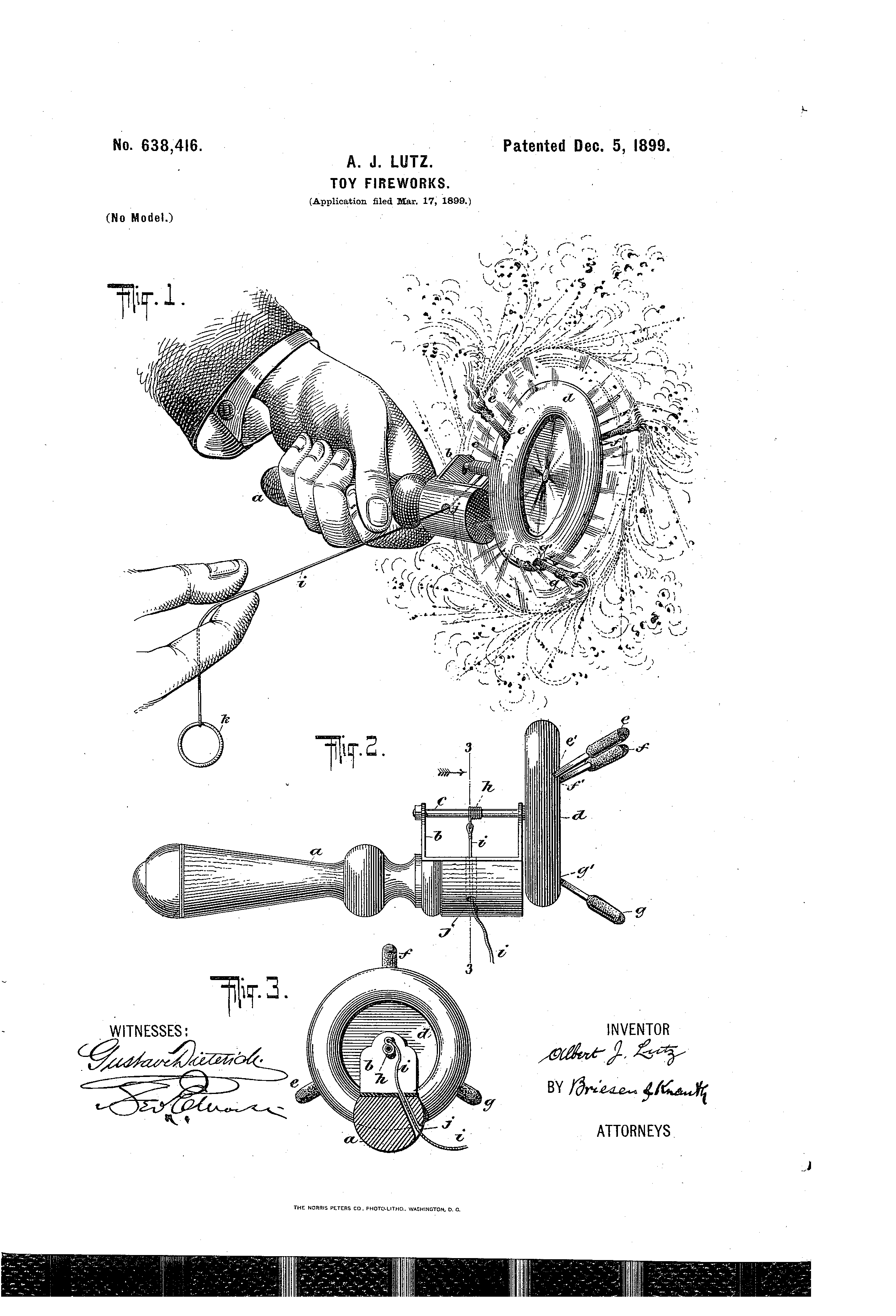
In more recent years, inventors for The Walt Disney Company developed U.S. Patent No. 5,339,741. The patent for “Precision Fireworks Display System Having a Decreased Environmental Impact” was issued on August 23, 1994. The invention launches “projectiles, such as fireworks, which explode in the air into a pyrotechnic display.” This system produces fireworks that display images such as an outline of Mickey Mouse’s head. If you find yourself wondering about the intellectual property behind your Independence Day celebration, you can email your questions to info@suiter.com. We're also active on Facebook and Instagram.
If you find yourself wondering about the intellectual property behind your Independence Day celebration, you can email your questions to info@suiter.com. We're also active on Facebook and Instagram.
However you choose to celebrate, we here at Suiter Swantz IP wish you a safe and happy Fourth of July!
Suiter Swantz IP is a full-service intellectual property law firm providing client-centric patent, trademark, and copyright services. If you need assistance with an intellectual property matter and would like to speak with one of our attorneys, please contact us at info@suiter.com.
5 Baseball Patents You Won't Find at the Men's College World Series
As the NCAA Men’s College World Series comes to an end, fans from around the country are gathering in Omaha, Nebraska to root for their favorite team.
In honor of the “Greatest Show on Dirt,” we would like to share a few interesting inventions and patents in baseball history.
“Base-ball catcher” U.S. Patent No. 755,209
Unlike what you may see at the Men's College World Series, catchers initially wore no protective equipment in baseball’s early years. They were commonly perceived as glorified backstops, distancing themselves from the batter, focused on preventing each pitch from getting away. As the game evolved, and more pitchers began throwing overhand, catchers needed better equipment to protect themselves. In 1904, James Bennett thought of a solution he called the “Base Ball Catcher.”
Bennett’s patented device was a rectangular open-wire frame body reinforced by slotted walls of wood. Springs at the rear of the device were put into place to protect catcher's chest from the blow of each pitch. Once the baseball passed through the front end, the contraption would drop the ball into the catcher’s hands so they could throw it back to the pitcher.
“Playing ball” U.S. Patent No. 2,324,277
While we’re reasonably confident this baseball never made its debut in a College World Series game, it would be remiss of us not to share this strange patent. In 1939, Thomas Casey filed a patent for a new kind of baseball in hopes that it would be a big hit with children everywhere. In 1943, Casey’s patent was granted, and while the face did not have a name, it sure is memorable.
“Ball bat” U.S. Patent No. 838,257
Unlike many aspects of the game, the baseball bat has been left primarily unchanged since the 19th century. Originally, bats tended to be much larger and more substantial than todays. The thinking was that the bigger the bat, the more mass behind the swing, and the bigger the hit.
In 1890, Emile Kinst was concerned with not only the bat’s size but how a bat could put a greater spin on batted balls. Thus, Kinst introduced a curved design for bats and was eventually granted a patent for “Ball Bat” in 1906.
“The object of my invention is to provide a ball-bat which shall produce a rotary or spinning motion of the ball in its flight to a higher degree than is possible with any present known form of ball-bat, and thus to make it more difficult to catch the ball.”
It is important to note that at the time of Kinst’s invention, baseball gloves were not yet universally accepted, so a rapidly spinning ball would be far more difficult to field. While Kinst’s “Ball bat” was never widely used, several were produced and named by the public as, "banana bats."
"Retractable baseball bat" U.S. Patent No. 7,166,046
While baseball bats have not undergone many structural changes historically, this patent seems like it could be useful to younger individuals learning how to play the game.
Chao-Jih Liu was granted a patent for his "Retractable baseball bat" in 2007. This bat is made of an ethylene vinyl acetate (EVA) foam material that can be expanded and contracted to fit the intended user's physical size. While the retractable bat doesn't appear on the NCAA's list of Certified Bats, we still appreciate its ingenuity.
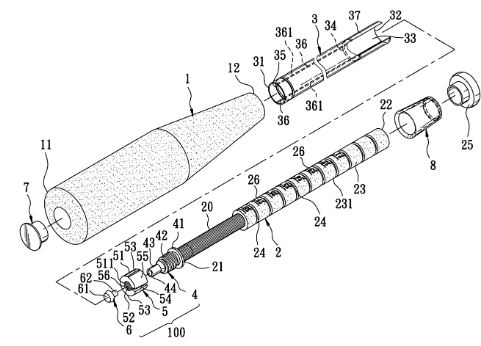
"Container for holding popcorn and a drink cup" U.S. Patent No. 4,491,220
Hot dogs, peanuts, cotton candy, nachos... There never seems to be a shortage of delicious food at TD Ameritrade Park; However, if you're bringing children to the games this week, it's almost guaranteed that you will run out of hands to hold all of the scrumptious snacks available. On January 1, 1985, Gilbert P. Daviss created a solution to this issue he called, "Container for holding popcorn and a drink cup."
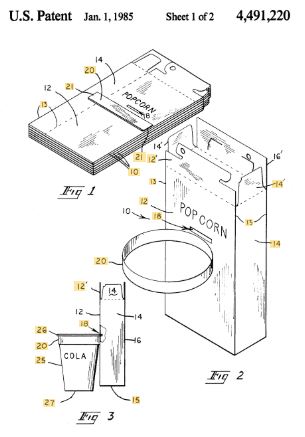
With the return of alcohol sales to the College World Series, it might not be long before baseball fans are utilizing a gadget like this to enjoy their cold refreshing drink with popcorn or peanuts.
If you find yourself pondering the intellectual property behind “America’s Great Pastime,” you can email your questions to info@suiter.com. We're also active on Facebook and Instagram. If you’re visiting Omaha for the College World Series, we hope you enjoy your stay in the city we call home.
Suiter Swantz IP is a full-service intellectual property law firm providing client-centric patent, trademark, and copyright services. If you need assistance with an intellectual property matter and would like to speak with one of our attorneys, please contact us at info@suiter.com.
The Patent that Led to the Creation of Morse Code
On June 20, 1840, Samuel F. B. Morse was granted U.S. Patent No. 1,647A, "IMPROVEMENT IN THE MODE OF COMMUNICATING INFORMATION BY SIGNALS BY THE APPLICATION OF ELECTROMAGNETISM." This invention later led to the creation of Morse Code.
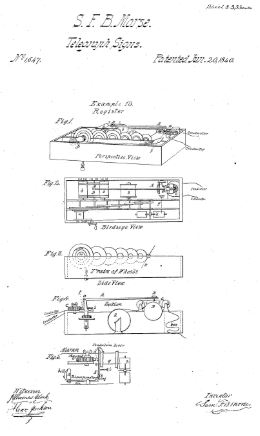
In 1832, Samuel Finley Breese Morse began perfecting his version of an electric telegraph after he missed the death of his wife due to lag in communication. Morse's electric telegraph consisted of eight parts:
- A circuit of electric or galvanic conductors
- A system of signs to communicate in the before-described circuit
- A set of type adapted to regulate the communication
- An apparatus called the “straight port-rule," and another called the “ circular port-rule"
- A signal-lever
- A register which records permanently the signs communicated at any desired points in the circuit
- A dictionary that translated pulses into numbers
- Modes of laying the circuit of conductors.
Following the construction, it was apparent that a critical piece was still needed to effectively use the telegraph. A code was needed to transmit natural language using only pulses and the silence between them.
In 1836, the development of The Morse Code began with the help from inventor Alfred Vail. Eventually, Morse Code allowed operators to translate pulses and pauses into letters, words, and phrases which led to many other advancements in communication as we know today.
To learn more about the electric telegraph's construct, you can find the full patent here.
---
Suiter Swantz IP is a full-service intellectual property law firm providing client-centric patent, trademark, and copyright services. If you need assistance with an intellectual property matter and would like to speak with one of our attorneys, please contact us at info@suiter.com.
Intellectual Property and the 4th of July
Independence Day, or Fourth of July, has been a federal holiday in the United States since 1941, but has been observed since 1777, the first anniversary of the signing of the Declaration of Independence. Fireworks are commonly used in celebrations and, not surprisingly, the intellectual property protecting fireworks is quite complicated.
Why do we Celebrate with Fireworks?
Grand displays of fireworks have been used to celebrate Fourth of July since the first Independence Day celebrations. Before the Declaration of Independence was even signed, John Adams envisioned fireworks as part of the festivities. In a letter to Abigail Adams on July 3, 1776, he wrote that the occasion should be commemorated “with Pomp and Parade, with Shews, Games, Sports, Guns, Bells, Bonfires and Illuminations from one End of this Continent to the other from this Time forward forever more.”
The first commemorative Independence Day fireworks were set off on July 4, 1777. Most early fireworks were re-purposed military munitions, fired for entertainment rather than military purposes.
During the Renaissance, fireworks became popular in Europe and were used in nationalist and imperialist celebrations by figures like Peter the Great and Louis XIV, a practice the new citizens of the United States of America would later adopt to celebrate their new country.
How do fireworks work?
The first firework was made by a Chinese monk named Li Tan over 1,000 years ago. He stuffed a piece of bamboo with gunpowder and and threw it into a fire. Due to the fast burning gun powder and compression of the bamboo, the result was a small explosion, which created a loud bang. Colors were incorporated into fireworks during the Italian Renaissance by adding steel and charcoal to produce yellow and orange. More colors were added to displays by incorporating different metals, which when heated emit characteristic wavelengths of light (i.e., colors).
To launch fireworks into the air, pyrotechnics use a chain of two explosions. They load a firework into a “mortar”, a tube that is essentially a cannon. They spark a fast-burning fuse that ignites the gunpowder, which is packed in a separate compartment at the bottom of the firework. A package shoots into the sky that contains an outer shell made of plastic or paper filled with gunpowder embedded with explosive spheres called “stars”, which become the points of light we see in a firework. A “time delay fuse” runs through the firework and ignites at the same time as the fast burning fuse, but it takes longer to reach the gunpowder and stars inside the firework. Pyrotechnics calculate the length of the time-delay fuse so that the firework does not ignite until it has reached a certain altitude.
More complex fireworks can be created by stringing fuses together and building chambers of gunpowder in the firework. “Pattern shells,” which rely on time-delay fuses within the firework and other techniques, can cause the stars to explode in recognizable shapes. Firework technology continues to evolve and firework designers are starting to use compressed air instead of gunpowder, which is considered safer and allows for greater precision. There is also ongoing research into making the process more environmentally friendly by using alternative ingredients.
Can you Copyright a Firework Show?
A visual art work must be “fixed” in a “tangible medium of expression” to be eligible for copyright protection. To gain protection the work must be embodied in some form that allows the work to be “perceived, reproduced, or otherwise communicated for a period of more than a transitionary duration.” The copyright office reviews creative works on a case-by-case basis. Some works may not be sufficiently fixed to warrant registration. The office cannot register a work created in a medium that is not intended to exist for more than a transitionary period, or in a medium that is constantly changing.
It is worth noting that the fact that uncopyrightable subject matter has been fixed through reproduction does not transform the underlying subject matter into copyrightable material. For example, a photograph or video of a fireworks display may be a copyrightable fixation of the photographic image(s) of the fireworks display, but the fireworks themselves do not constitute copyrightable subject matter. According to the Berne Convention, an international agreement governing copyright, a work can be protected by copyright only when it is written or recorded on a fixed medium. Since a firework display is not recorded on a fixed medium it does not receive copyright protection and it can be photographed but not always recorded/filmed. The photograph taken of the display can be protected as an original photographic/artistic work, with the copyright typically owned by the photographer. Therefore, you are free to upload any photographs taken at a fireworks display.
Music accompanying fireworks adds to the fireworks-watching experience, however, using non-original music may present a number of copyright law issues. All musical works and compositions considered to be in the ‘public domain’ are exempt from the protections of the copyright law. While most modern musical works and compositions qualify for copyright protection for up to 95 years, all musical compositions created before 1922 are, preemptively, in the public domain.
Many firework displays are paired with local radio stations that provide simultaneous transmission of the music selected for the display. In these instances, it is commonplace for the radio station to comply with copyright laws to the extent that they may apply to a particular display through the use of their blanket license to air the music. Nothing prevents a fireworks display company from requiring the display sponsor to accept responsibility for all copyright and performance obligation licenses.
Many theme parks and large firework display sponsors rely on original musical works and compositions, completely avoiding payment of royalties and claims of infringement. These companies frequently register their original musical work and compositions in order to protect against infringement from competitors.
Private displays are considered to be non-public and non-commercial in nature. Private firework displays are not likely to have the same concerns when using non-original music. Civil enforcement actions in the context of fireworks displays are rare due to the expense of copyright infringement lawsuits.
Bastille Day is a French national holiday commemorating the storming of the Bastille, an important episode in the French Revolution. Each year, fireworks are set off from the Eiffel Tower. When the 100th anniversary of the building of the Eiffel Tower was commemorated, the French Supreme Court held that a show “consisting of lighting effects of the tower by a combination of ramps and projectors, along with image projections and fireworks” is a work of art protected by copyright. With this holding, the Court affirmed a lower court’s decision that a publisher cannot sell postcards reproducing photographs of the show without the show designer’s prior authorization.
Can you Patent Fireworks?
There are several patents involving fireworks. One of the earliest fireworks patents, U.S. Patent No. 638,416A, issued in 1899 and is entitled TOY FIREWORKS. Fireworks lovers across the nation can also thank inventor Gioiosa Joseph for improving upon the firework design. Gioiosa’s 1930 FIREWORKS patent allowed for smaller displays to be put on more safely, without fear of losing limbs by clamping the firework to a stable object while being discharged.
One company many associate with Mickey Mouse ® and a certain magical kingdom is also a large holder of firework patents. The Walt Disney Company has been assigned many firework patents over the years, including U.S. Patent No. 5,627,338, entitled FIREWORKS PROJECTILE HAVING DISTINCT SHELL CONFIGURATION. This patent covers a projectile that “includes a shell constructed from a binding agent and an explosive additive which explodes the shell into small particles… the external geometry of the projectile also is configured so that the projectile tumbles when launched and follows a more predictable, repeatable, and accurate path in flight.” Disney also owns a patent on an ELECTRONIC TIME FUZE, which is an electronic time fuse for controlling and initiating the explosion of an explosive (U.S. Patent No. 5,440,990). Finally, Disney owns a patent for Precision Fireworks Display System Having a Decreased Environmental Impact, which allows for the explosives to rapidly burn so they turn into flakes that are harmless by the time they reach the ground.
So, this 4th of July when you’re sitting back and enjoying your local fireworks display feel safe to snap a few pictures and remember many of the fireworks you will be enjoying could be patented.
Everyone at Suiter Swantz IP would like to wish you a safe and happy Fourth of July.
Suiter Swantz IP is a full-service intellectual property law firm providing client-centric patent, trademark, and copyright services. If you need assistance with an intellectual property matter and would like to speak with one of our attorneys, please contact us at info@suiter.com.
The Youngest Person to Receive a U.S. Patent
On June 4, 1963, Robert W. Patch became the youngest person to receive a U.S. patent. Patch’s “Toy Truck” (U.S. Patent No. 3,091,888) allowed for a toy truck to be taken apart and reassembled in various configurations. Not so unusual, unless you consider Patch was unable to sign his name at the time the patent was filed. Patch, at the remarkable age of six, signed the application with an “X.”
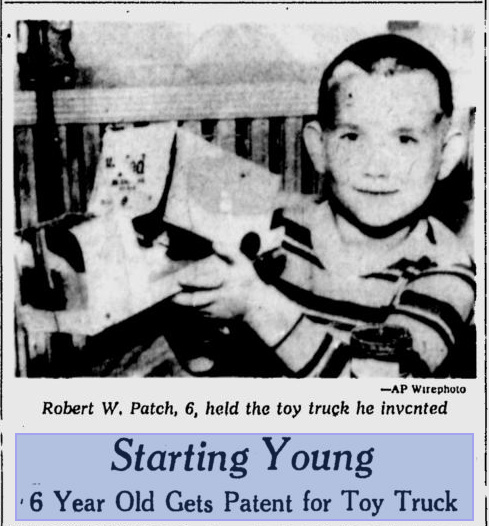
Like many young boys, Robert Patch of Chevy Chase, Maryland enjoyed playing with toys but was always challenging their capabilities. Thus, he created a toy truck using a shoe box, a few bottle caps, and nails.
His father, a patent attorney, decided that his son’s invention was unique and patentable, so he created and submitted drawings on behalf of his son to the United States Patent and Trademark Office. The idea behind the patent dissipated shortly after the patent was issued; However, Patch remains the youngest person to receive a U.S. patent.
Various news organizations recognized Patch for being the youngest person to receive a U.S. patent. Consequently, several images of him and his original design, which featured a Keds brand shoe box, cycled in the news. When Keds saw Patch’s picture, they sent him a pair of shoes, which was the only tangible reward Patch had ever received as a result of his patent.
While Patch did not go on to be a prolific inventor, he did start a roofing business, married, has a son, and continues to claim his little place in history.
—
Suiter Swantz IP is a full-service intellectual property law firm providing client-centric patent, trademark, and copyright services. If you need assistance with an intellectual property matter and would like to speak with one of our attorneys, please contact us at info@suiter.com.
Oral Arguments Heard by Supreme Court in Oil States Energy v. Greene's Energy
Monday November 27, 2017, the Supreme Court of the United States heard oral arguments in Oil States Energy Services LLC v. Greene’s Energy Group, LLC. The question before the Court was “whether inter partes review [IPR], an adversarial process used by the Patent and Trademark Office (PTO) to analyze the validity of existing patents, violates the Constitution by extinguishing private property rights through a non-Article III forum without a jury.”
The IPR procedure was established as part of the Leahy-Smith America Invents Act designed to “establish a more efficient and streamlined patent system that will improve patent quality and limit unnecessary and counterproductive litigation costs.” IPR provides a mechanism allowing a third party to challenge a patent issued for over nine months based on a lack of novelty or non-obviousness. If the Patent Trial and Appeals Board (PTAB) grants a third party’s petition for an IPR they will oversee the proceeding, and provide a final written decision. The claims of the challenged patent could potentially be invalidated.
Oil States Energy Services LLC owns U.S. Patent No. 6,179,053 directed to protecting wellheads during hydraulic fracturing (fracking). Oil States sued Greene’s Energy Group, LLC for infringement of this patent. Greene’s Energy filed a petition for an IPR to challenge the patent in what has become a common defensive strategy. After the PTAB held the ‘053 patent invalid, Oil States appealed to the Federal Circuit.
In the petition for writ of certiorari, Oil States challenged the constitutionality of hearing an IPR hearing in front of the PTAB, an administrative court, claiming that “suits to invalidate patents must be tried before a jury in an Article III forum, not in an agency proceeding.”
Not surprisingly, critics feel that IPR proceedings in front of the PTAB should be eliminated as the process serves a redundant function to that already offered by the federal courts, which many believe should be the sole venue for invalidity cases.
Proponents of IPR proceedings believe they are a valuable tool for reviewing the validity of issued patents and reducing the amount of costly litigation in federal courts and thereby improve the efficiency and reduce the cost of the patent system as a whole.
After hearing oral arguments, the Justices appear to be split, largely along political ideology. Based on the line of questioning, the more liberal Justices, Ruth Bader Ginsburg, Elena Kagan, and Sonia Sotomayor seemed accepting of IPR proceedings, noting that the USPTO has long had the power to invalidate patents as well as the ability to grant patents after the fact. Justice Ginsburg stated “there must be some means by which the USPTO can correct the errors it’s made.” Justice Sotomayor added that this system is saved by the fact that “a patent invalidity finding can be appealed to a court” for judicial review.
Conservative Justices, John Roberts and Neil Gorsuch, seemed concerned over the government’s ability to easily revoke patents. Justice Gorsuch agreed that there is judicial review, but “only if someone appeals” the IPR decision. Justice Gorsuch also believes that a patent, once granted, is “a private right belonging to the inventor.” Chief Justice Roberts and Justice Gorsuch also detailed their concerns over the fact that the statutory design of IPRs allows the PTO to “stack the deck with judges” who will vote in a manner favorable to the USPTO.
When questioning Greene’s Energy’s attorney on the issue of patent validity review in the PTAB, Chief Justice Roberts asked “your position…is simply that you’ve got to take the bitter with the sweet. If you want the sweet of having a patent, you’ve got to take the bitter that the government might reevaluate it at some subsequent point.” To which Greene’s Energy’s counsel replied, “Yes.”
Justice Breyer approached the issue from a financial practicality perspective. While Beyer did not specifically let his views on the constitutionality of IPRs known, he did take issue with the fact that a patent, that was allegedly mistakenly issued, could be reexamined years after it had been granted even after a patent owner or licensee invested large sums of money to develop the technology in reliance on the patent’s enforceability.
It is unclear at this stage how The Supreme Court will rule. The options to the Court are straightforward. The Court can i) hold that IPR proceedings are constitutional and solidify the current IPR procedures within the USPTO; ii) find the procedure wholly unconstitutional; or iii) come to a piecemeal resolution by finding the procedure unconstitutional in part. No matter the outcome, Oil States v. Greene’s Energy will be considered a landmark decision for years to come.
Suiter Swantz IP is a full-service intellectual property law firm, based in Omaha, NE, serving all of Nebraska, Iowa, and South Dakota. If you have any intellectual property questions or need assistance with any patent, trademark, or copyright matters and would like to speak with one of our patent attorneys please contact us.
Andrei Iancu Named as Nominee for USPTO Director
The Trump administration announced on Friday August 25, 2017 that the President will nominate Andrei Iancu as the next director of the United States Patent and Trademark Office (USPTO).
Assuming that Congress approves Iancu's nomination, he will fill the position previously held by Michelle Lee, who served as USPTO Director during the Obama administration and into the early stages of the Trump administration before officially stepping down on June 6, 2017.
The Iancu nomination will likely be well received by those seeking a strengthening of patent rights, which many believe were eroded under formed Director Lee's tenure. Iancu is currently the managing partner of Irell & Manella LLP, a Los Angeles-based intellectual property firm and has represented a number of plaintiffs in patent-related lawsuits. Of note, Iancu represented Tivo Corp. in a patent dispute against Verizon, AT&T, Cisco, and Microscoft. Tivo received a collective settlement amount of $1.6 billion from the parties.
Suiter Swantz IP is a full-service intellectual property law firm based in Omaha, NE, serving all of Nebraska, Iowa, and South Dakota. If you have any intellectual property questions or need assistance with any patent, trademark, or copyright matters and would like to speak to one of our patent attorneys please feel free to contact us.

